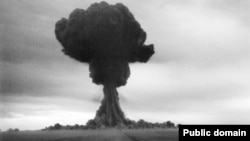August 29 marks 30 years since Kazakhstan closed its Semipalatinsk test site, a vast, remote area that was used by the Soviet Union for hundreds of atmospheric and underground nuclear tests over a period of 40 years.
On August 29, 1991 former President Nursultan Nazarbaev decided to close the test site, also known as "The Polygon," which the following years became the focus of close cooperation between the United States, Russia, and Kazakhstan to secure nuclear material and address smuggling risks.
The effort involved the transfer of hundreds of nuclear weapons to Russia, the shutdown of plutonium production facilities, the removal of hundreds of kilograms of highly enriched uranium, and the reemployment of scientists.
To do the job, the United States provided funds and project management, Moscow provided scientists and historical information, and Kazakh authorities provided access and project implementers.
Much of the work was completed in 2012 at a cost of over $150 million, with then President Barack Obama lauding it as “a consequence of extraordinary cooperation between our three countries.”
However, local people continue to suffer the consequences of four decades of exposure to radiation.
In the nuclear arms race against the United States, the Soviet Union performed at least 468 nuclear tests at Semipalatinsk between 1949 and 1989.
The site spanning an area of 18,500 square kilometers was uninhabited, but winds blew the nuclear fallout and radioactive dust into neighboring villages, affecting hundreds of thousands of people.
Exposed adults developed a range of fatal cancers, and women gave birth to children with physical or neurological defects.
The government officially has recognized more than 1 million people as being negatively affected by the nuclear tests, entitling them to social benefits.
But residents of settlements located around the test site complain that such benefits are insufficient and hardly allow them to make ends meet. They also say that the harmful impact of nuclear tests was transmitted from generation to generation.
In an analysis published earlier this week, Leon Ratz, senior program officer at the Washington-based Nuclear Threat Initiative, noted that “the Semipalatinsk story is not quite finished.”
“While the concrete caps and plutonium-cement mixtures at [the facility] have greatly reduced the proliferation risks posed by the nuclear materials left behind there, they have not eliminated them all together,” Ratz wrote.
“As long as the nuclear materials remain buried in those tunnels, the security, proliferation, and environmental risks will have to be managed. Kazakhstan will need to maintain effective security around this vast site with a well-trained, well-equipped response force. Environmental impacts will have to be continuously assessed.”
